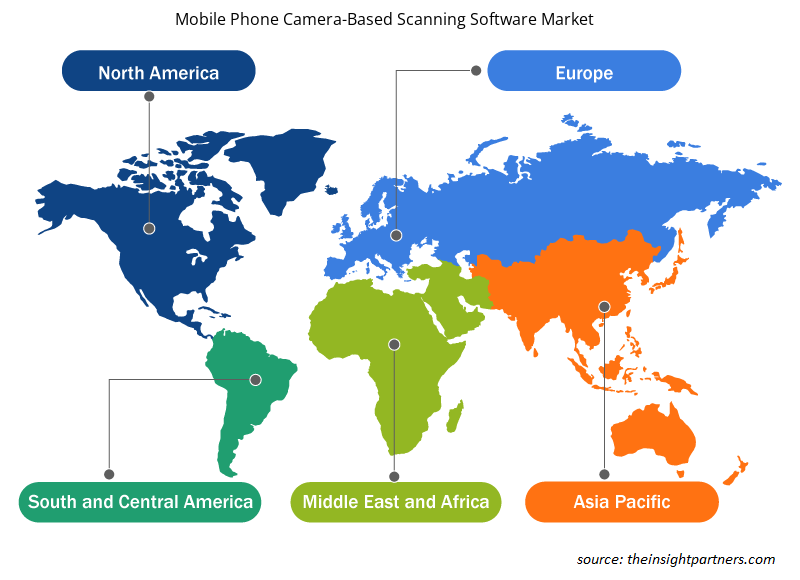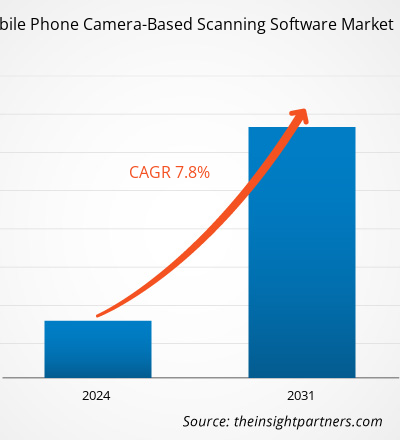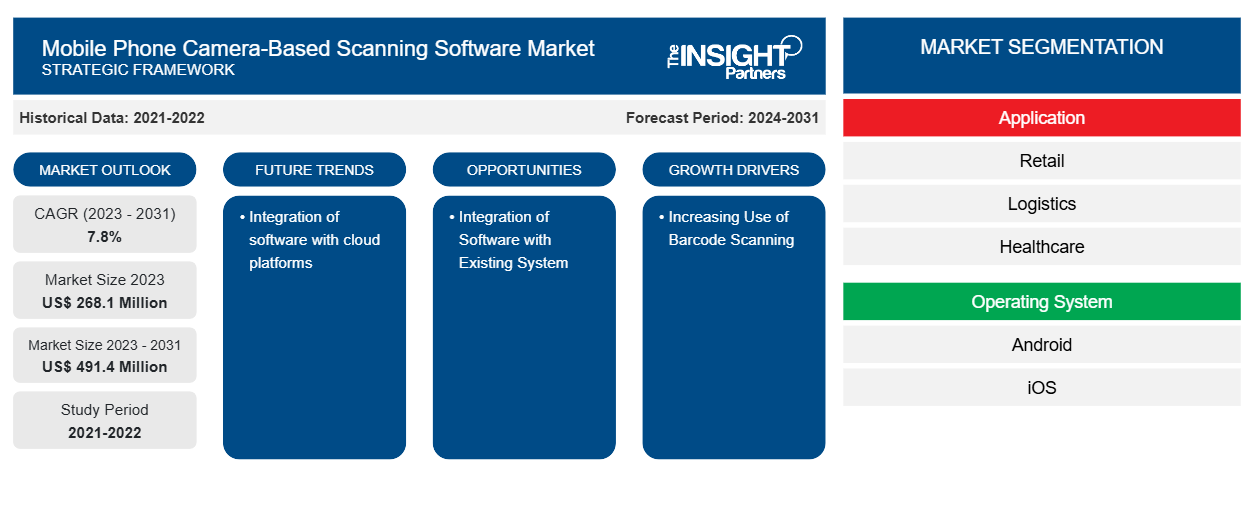Der Markt für kamerabasierte Scansoftware für Mobiltelefone soll von 268,1 Millionen US-Dollar im Jahr 2023 auf 491,4 Millionen US-Dollar im Jahr 2031 anwachsen. Der Markt dürfte zwischen 2023 und 2031 eine durchschnittliche jährliche Wachstumsrate von 7,8 % verzeichnen. Die Integration von Software in Cloud-Plattformen dürfte ein wichtiger Trend auf dem Markt bleiben.
Marktanalyse für kamerabasierte Scansoftware für Mobiltelefone
Scansoftware wird die Arbeitsweise von Unternehmen grundlegend verändern und bietet eine Vielzahl von Vorteilen gegenüber herkömmlichen Hardware-Barcodescannern. Durch den Einsatz einer softwarebasierten Scanlösung können Unternehmen ihre Effizienz steigern, die Genauigkeit verbessern und wertvolle Erkenntnisse gewinnen, was letztendlich zu Wachstum und Erfolg führt. Barcode -Scansoftware hat verschiedene Branchen revolutioniert, darunter den Einzelhandel, um die Bestandsverwaltung, Produktverfolgung und Kassenvorgänge zu optimieren. In der Logistik werden die Datenerfassung automatisiert, Sendungen verfolgt und Lagervorgänge optimiert. Im Gesundheitswesen werden die Patientenidentifikation, die Medikamentenverabreichung und die Verwaltung von Krankenakten verbessert.
Marktübersicht für kamerabasierte Scansoftware für Mobiltelefone
Barcode-Scanning-Software verwendet Softwarealgorithmen zum Dekodieren von Barcodes, die mit Digitalkameras oder Mobilgeräten erfasst wurden. Im Gegensatz zu Hardware-Barcode-Scannern, die Spezialgeräte erfordern, können Barcode-Softwarelösungen in vorhandene Geräte und Anwendungen integriert werden, was für mehr Flexibilität und Kosteneinsparungen sorgt. Scanning-Software wird häufig als Barcode-Scanner-API oder einfach als Barcode-API bezeichnet. Barcode-Scanning-Software bietet eine Vielzahl von Vorteilen gegenüber herkömmlichen Hardware-Barcode-Scannern. Sie bietet Flexibilität und Lösungen können leicht an verschiedene Scanning-Szenarien und Kamerakonfigurationen angepasst werden, wodurch sie für eine Vielzahl von Anwendungen geeignet sind. Die Software macht spezielle Hardware überflüssig und reduziert die Vorlaufkosten. Darüber hinaus erfordern Scanning-Softwarelösungen oft nur minimale Wartung und Updates, was die langfristigen Kosten senkt.
Passen Sie diesen Bericht Ihren Anforderungen an
Sie erhalten kostenlos individuelle Anpassungen an jedem Bericht, einschließlich Teilen dieses Berichts oder einer Analyse auf Länderebene, eines Excel-Datenpakets sowie tolle Angebote und Rabatte für Start-ups und Universitäten.
-
Holen Sie sich die wichtigsten Markttrends aus diesem Bericht.Dieses KOSTENLOSE Beispiel umfasst eine Datenanalyse von Markttrends bis hin zu Schätzungen und Prognosen.
Markttreiber und Chancen für kamerabasierte Scansoftware für Mobiltelefone
Zunehmende Nutzung von Barcode-Scanning zur Förderung des Marktes
Unternehmen, Lager und andere Einrichtungen, die auf manuelle Dateneingabe angewiesen sind, leiden unter einer hohen Fehlerquote. Mitarbeiter, die Daten von Hand eingeben, vertauschen viel zu häufig Zahlen, überspringen eine Zeile, verstehen eine Zahl falsch oder verwenden eine schreckliche Handschrift, die andere nicht lesen können. Barcodes hingegen reduzieren die Wahrscheinlichkeit menschlicher Fehler erheblich und schließen sie fast vollständig aus. Barcode-Scans sind effizienter, zuverlässiger und weniger zeitaufwändig als die manuelle Dateneingabe. Unternehmen, die darum kämpfen, die Lagerhaltungskosten zu senken, profitieren ebenfalls von der Implementierung von Barcode-Programmen. Barcodes ermöglichen es Unternehmen, den Lagerbestand in Echtzeit mit sofortigen, genauen Updates zu aktualisieren, die wahre Bestandszahlen liefern. Genauere Bestandszahlen tragen zu einer verbesserten Effizienz bei, da sie es Unternehmen ermöglichen, genauere Lieferzeiten festzulegen, die Lagerkosten genauer zu definieren und einen höheren Marktpreis zu erzielen. Dies erhöht die Verwendung von Barcodes und treibt das Wachstum kamerabasierter Barcode-Scan-Software voran.Barcodes, on the other hand, significantly reduce the likelihood of human error to the point of almost eliminating it. Barcode scans are more efficient, reliable, and less time-consuming than manual data entry. Companies that are struggling to reduce inventory carrying costs also benefit from implementing barcode programs. Barcodes empower companies to update inventory in real time with immediate, accurate updates that deliver true inventory counts. More accurate inventory counts contribute to improved efficiency because they enable companies to establish more accurate delivery times, a more accurate definition of inventory costs, and a higher price to market. Thus increasing us of barcodes and driving the growth of camera-based barcode scanning software.
Integration der Software in bestehende Systeme
Auf Mobiltelefonkameras basierende Scansoftware bietet eine Reihe von Funktionen und Möglichkeiten, die über das herkömmliche Barcode-Scannen hinausgehen, darunter Datenerfassung, -verarbeitung und Integration in vorhandene Systeme oder Software. Sie können Daten mit zentralen Datenbanken synchronisieren, mit POS-Systemen oder Bestandsverwaltungssoftware kommunizieren und Informationen drahtlos übertragen, um Echtzeitaktualisierungen und Genauigkeit zu gewährleisten. Diese Software kann angepasst oder entwickelt werden, um sich nahtlos in vorhandene Systeme wie Bestandsverwaltungssoftware, Point-of-Sale-Systeme (POS), Customer-Relationship- Management-Software (CRM) und Enterprise-Ressource-Planning-Systeme (ERP) zu integrieren. Diese Kompatibilität ermöglicht es Unternehmen, ihre vorhandene Softwareinfrastruktur zu nutzen und die Betriebseffizienz so weit wie möglich zu optimieren. Die Integration in vorhandene Systeme bietet somit eine Chance für das Wachstum des Markierers.barcode scanning, including data collection, processing, and integration with existing systems or software. They can synchronize data with central databases, communicate with POS systems or inventory management software, and transfer information wirelessly to ensure real-time updates and accuracy. This software can be customized or developed to seamlessly integrate with existing systems like inventory management software, point-of-sale (POS) systems, CRM) software, and enterprise resource planning (ERP) systems. This compatibility empowers businesses to harness their existing software infrastructure, optimizing operational efficiency to the fullest extent possible. Thus, integration with existing systems creates an opportunity for the growth of the marker.
Marktbericht zur auf Mobiltelefonkameras basierenden Scansoftware – Segmentierungsanalyse
Wichtige Segmente, die zur Ableitung der Marktanalyse für auf Mobiltelefonkameras basierende Scansoftware beigetragen haben, sind Anwendung und Betriebssystem.
- Basierend auf der Anwendung ist der Markt für auf Mobiltelefonkameras basierende Scansoftware in die Bereiche Einzelhandel, Logistik, Gesundheitswesen, Gastgewerbe, Post und Sonstige unterteilt.
- In Bezug auf die Betriebssysteme ist der Markt in Android und iOS segmentiert.
Marktanteilsanalyse für kamerabasierte Scansoftware für Mobiltelefone nach geografischen Gesichtspunkten
Der geografische Umfang des Marktberichts über kamerabasierte Scansoftware für Mobiltelefone ist hauptsächlich in fünf Regionen unterteilt: Nordamerika, Asien-Pazifik, Europa, Naher Osten und Afrika sowie Süd- und Mittelamerika. Nordamerika ist ein entwickeltes Land mit verschiedenen Softwareentwicklern und Anbietern digitaler Lösungen. Unternehmen in ganz Nordamerika setzen auf Software und digitale Lösungen. Die Entwicklung der Smartphone-Technologie wird in allen Regionen immer ausgefeilter; immer mehr Entwickler versuchen, die Leistungsfähigkeit von Smartphones zu verbessern. Eine solche Funktionalität war die Verwendung der Kameratechnologie nicht nur als Bildaufnahmegerät, sondern auch als Scannerersatzgerät zur Steigerung der Produktivität.
Regionale Einblicke in den Markt für kamerabasierte Scansoftware für Mobiltelefone
Die regionalen Trends und Faktoren, die den Markt für kamerabasierte Scansoftware für Mobiltelefone im Prognosezeitraum beeinflussen, wurden von den Analysten von Insight Partners ausführlich erläutert. In diesem Abschnitt werden auch die Marktsegmente und die Geografie für kamerabasierte Scansoftware für Mobiltelefone in Nordamerika, Europa, im asiatisch-pazifischen Raum, im Nahen Osten und Afrika sowie in Süd- und Mittelamerika erörtert.

- Erhalten Sie regionale Daten zum Markt für kamerabasierte Scansoftware für Mobiltelefone
Umfang des Marktberichts über kamerabasierte Scansoftware für Mobiltelefone
| Berichtsattribut | Details |
|---|---|
| Marktgröße im Jahr 2023 | 268,1 Millionen US-Dollar |
| Marktgröße bis 2031 | 491,4 Millionen US-Dollar |
| Globale CAGR (2023 - 2031) | 7,8 % |
| Historische Daten | 2021-2022 |
| Prognosezeitraum | 2024–2031 |
| Abgedeckte Segmente |
Nach Anwendung
|
| Abgedeckte Regionen und Länder |
Nordamerika
|
| Marktführer und wichtige Unternehmensprofile |
|
Dichte der Marktteilnehmer für kamerabasierte Scansoftware für Mobiltelefone: Auswirkungen auf die Geschäftsdynamik verstehen
Der Markt für Software zum Scannen von Mobiltelefonkameras wächst rasant. Dies wird durch die steigende Nachfrage der Endnutzer aufgrund von Faktoren wie sich entwickelnden Verbraucherpräferenzen, technologischen Fortschritten und einem größeren Bewusstsein für die Vorteile des Produkts vorangetrieben. Mit der steigenden Nachfrage erweitern Unternehmen ihr Angebot, entwickeln Innovationen, um die Bedürfnisse der Verbraucher zu erfüllen, und nutzen neue Trends, was das Marktwachstum weiter ankurbelt.
Die Marktteilnehmerdichte bezieht sich auf die Verteilung der Firmen oder Unternehmen, die in einem bestimmten Markt oder einer bestimmten Branche tätig sind. Sie gibt an, wie viele Wettbewerber (Marktteilnehmer) in einem bestimmten Marktraum im Verhältnis zu seiner Größe oder seinem gesamten Marktwert präsent sind.
Die wichtigsten Unternehmen auf dem Markt für kamerabasierte Scansoftware für Mobiltelefone sind:
- Scandit
- RIOTEC Co., Ltd. co., Ltd.
- Grabba
- MARSON TECHNOLOGY CO., LTD TECHNOLOGY CO., LTD
- KOAMTAC
- Cognex Corporation Corporation
Haftungsausschluss : Die oben aufgeführten Unternehmen sind nicht in einer bestimmten Reihenfolge aufgeführt.

- Überblick über die wichtigsten Akteure auf dem Markt für kamerabasierte Scan-Software für Mobiltelefone
Marktnachrichten und aktuelle Entwicklungen zu kamerabasierter Scansoftware für Mobiltelefone
Der Markt für auf Mobiltelefonkameras basierende Scansoftware wird durch die Erfassung qualitativer und quantitativer Daten nach Primär- und Sekundärforschung bewertet, die wichtige Unternehmensveröffentlichungen, Verbandsdaten und Datenbanken umfasst. Nachfolgend sind einige der Entwicklungen auf dem Markt für auf Mobiltelefonkameras basierende Scansoftware aufgeführt:
- Scandit, die Enterprise-Technologieplattform für mobile Computervision und Augmented Reality (AR), hat bekannt gegeben, dass Consignor, eine Multi-Carrier-Versandlösung, Scandits Barcode Scanner SDK in seine neue Scan App Pro integriert hat, was schnelles und zuverlässiges Scannen mit einer konkurrenzlosen Barcode-Bibliothek ermöglicht. (Quelle: Scandit., Februar 2021), the enterprise technology platform for mobile computer vision and augmented reality (AR) has announced that Consignor, a multi-carrier shipping solution, has integrated Scandit's Barcode Scanner SDK into its new Scan App Pro, allowing for fast and reliable scanning with an unrivaled barcode library. (Source: Scandit., February 2021)
- Scandit, die führende Technologieplattform für mobile Computer Vision- und Augmented Reality (AR)-Lösungen für Unternehmen, gab bekannt, dass der Lebensmittelhändler MAXIMA das Barcode Scanner SDK in seine mobile MAXIMA-App integriert hat, sodass Kunden in 84 Filialen in ganz Estland mit ihrem Smartphone selbst scannen können. (Quelle: Scandit, Juni 2021), the leading technology platform for mobile computer vision and augmented reality (AR) solutions for businesses announced that grocery retailer MAXIMA had integrated Barcode Scanner SDK into its MAXIMA mobile app, allowing customers in 84 stores across Estonia to do self-scanning shopping using their smartphone. (Source: Scandit, June 2021)
Marktbericht zu kamerabasierter Scan-Software für Mobiltelefone – Umfang und Ergebnisse
Der Bericht „Marktgröße und Prognose für kamerabasierte Scan-Software für Mobiltelefone (2021–2031)“ bietet eine detaillierte Analyse des Marktes, die die folgenden Bereiche abdeckt:
- Marktgröße und Prognose für kamerabasierte Scansoftware für Mobiltelefone auf globaler, regionaler und Länderebene für alle wichtigen Marktsegmente, die im Rahmen des Berichts abgedeckt sind
- Markttrends für kamerabasierte Scansoftware für Mobiltelefone sowie Marktdynamiken wie Treiber, Einschränkungen und wichtige Chancen
- Detaillierte PEST/Porters Five Forces- und SWOT-Analyse
- Marktanalyse für kamerabasierte Scansoftware für Mobiltelefone mit wichtigen Markttrends, globalen und regionalen Rahmenbedingungen, wichtigen Akteuren, Vorschriften und aktuellen Marktentwicklungen
- Branchenlandschaft und Wettbewerbsanalyse, die die Marktkonzentration, Heatmap-Analyse, prominente Akteure und aktuelle Entwicklungen auf dem Markt für kamerabasierte Scansoftware für Mobiltelefone umfasst
- Detaillierte Firmenprofile
- Historische Analyse (2 Jahre), Basisjahr, Prognose (7 Jahre) mit CAGR
- PEST- und SWOT-Analyse
- Marktgröße Wert/Volumen – Global, Regional, Land
- Branchen- und Wettbewerbslandschaft
- Excel-Datensatz
Aktuelle Berichte
Verwandte Berichte
Erfahrungsberichte
Grund zum Kauf
- Fundierte Entscheidungsfindung
- Marktdynamik verstehen
- Wettbewerbsanalyse
- Kundeneinblicke
- Marktprognosen
- Risikominimierung
- Strategische Planung
- Investitionsbegründung
- Identifizierung neuer Märkte
- Verbesserung von Marketingstrategien
- Steigerung der Betriebseffizienz
- Anpassung an regulatorische Trends























 Kostenlose Probe anfordern für - Markt für kamerabasierte Scansoftware für Mobiltelefone
Kostenlose Probe anfordern für - Markt für kamerabasierte Scansoftware für Mobiltelefone